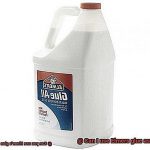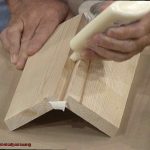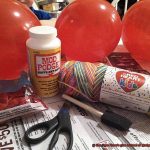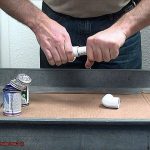Picture this: You’re in the middle of a woodworking project, and you’ve just realized that you’re out of wood glue. Panic sets in, and you start to wonder if Elmer’s school glue is a suitable alternative. But can you really use Elmer’s glue as wood glue?
Let’s take a step back and review what wood glue is and how it differs from other types of adhesive. Wood glue is specially formulated to create a strong bond between wood pieces. It can penetrate the wood fibers, creating a bond that can withstand stress and strain. On the other hand, school glue is primarily used for lighter craft projects and lacks the strength and durability needed for woodworking.
So, can you use Elmer’s glue as wood glue? The short answer is yes, but it’s not recommended for long-lasting or sturdy bonds. Elmer’s glue isn’t formulated precisely for woodworking projects, which means it won’t have the same hold on wood as specialized wood glues do. Using it as an alternative could cause your project to break or come apart easily.
Moreover, if your project will be exposed to water or high humidity environments, using Elmer’s glue will weaken the bond further.
In conclusion, while using Elmer’s glue as a replacement for wood glue may work in a pinch, it isn’t ideal for projects that require longevity and strength. It’s better to stick with specially formulated wood glues for those types of projects.
Can Elmers Glue be Used as Wood Glue?
Contents
- 1 Can Elmers Glue be Used as Wood Glue?
- 2 Advantages of Using Wood Glue
- 3 Disadvantages of Using Elmer’s Glue as Wood Glue
- 4 How to Choose the Right Type of Glue for Your Project
- 4.1 Choosing the Right Glue for Your Woodworking Project
- 4.2 Material Matters: The first thing you should consider when selecting glue is the material you are working with. Different types of glue work better with specific materials. For instance, PVA glue works well with porous materials like wood, while cyanoacrylate glue works best on non-porous surfaces like plastic.
- 5 Tips for Working with Wood Glue
- 6 Common Mistakes When Using Elmer’s Glue as a Substitute for Wood Glue
- 7 What to Do If You Accidentally Use Elmer’s Glue on a Woodworking Project
- 8 Alternatives to Using Elmer’s Glue for Woodworking Projects
- 9 Conclusion
While it may seem like a convenient option, the short answer is no. Let’s dive into why using Elmer’s glue for woodworking projects may not be the best choice.
Firstly, Elmer’s glue is designed for porous surfaces such as paper, cardboard, fabric, and some types of wood. However, it does not have the same strength and durability as wood glue. Wood glue is specifically formulated to bond wood fibers together, creating a strong and lasting hold that can withstand stress and movement without breaking down.
When it comes to woodworking projects, using Elmer’s glue instead of wood glue can lead to weak joints that break down over time. The glue may not penetrate the wood fibers as deeply as wood glue, resulting in a weaker bond that cannot hold up to exposure to moisture or changes in temperature.
In addition, Elmer’s glue can dry to a harder consistency than wood glue. This can make it difficult to sand or stain once it has dried, which can be problematic if you want your project to have a smooth finish. The harder consistency can also cause issues with joints and lead to cracking or splitting over time.
Overall, while Elmer’s glue may work in a pinch for certain woodworking projects, it is not recommended for long-term durability and strength. It may not hold up as well over time, particularly in high-stress areas such as joints. To ensure the best results when working with wood, it is important to use a wood glue that is specifically designed for woodworking applications.
Advantages of Using Wood Glue
This versatile adhesive has numerous benefits over other types of glue, making it the go-to choice for many DIYers and professionals alike.
One of the key advantages of using wood glue is its exceptional strength. It creates a bond between pieces of wood that can withstand stress and changes in temperature, making it an excellent choice for furniture and cabinetry projects. With wood glue, you can rest assured that your project will be durable and long-lasting.
But the benefits of wood glue don’t stop there. One of its greatest advantages is its versatility. Unlike other adhesives, wood glue can be used on a variety of different woods, including hardwoods, softwoods, and even plywood. This makes it the perfect option for any woodworking project you have in mind.
Another great thing about wood glue is its waterproof and heat-resistant properties. This means that it’s perfect for outdoor projects or items that will be exposed to moisture or heat. And when it comes time to clean up, all you need is water – it really is that easy.
Perhaps one of the best things about wood glue is its affordability and availability. You can find it at most hardware stores and home improvement centers, making it a convenient option for DIYers and professionals alike. And because it dries clear, it’s perfect for projects where appearance is important.
To sum up, some of the key advantages of using wood glue include:
- Exceptional strength
- Versatility across different types of woods
- Water-resistant and heat-resistant properties
- Easy clean-up with water
- Affordable and widely available
Disadvantages of Using Elmer’s Glue as Wood Glue
While it may seem like a convenient and cost-effective option, there are several disadvantages to keep in mind. As an expert in woodworking, I have compiled a list of the top reasons why using Elmer’s glue as wood glue may not be the best choice for your project.
Firstly, Elmer’s glue is designed for use on porous materials such as paper, cardboard, and fabrics. It lacks the same bonding strength as wood glue, which is specifically formulated for use on wood. This means that your project may not hold up as well over time, especially if it involves heavy loads or stresses. When working with high-quality wood, it’s essential to use the right adhesive to ensure its longevity.
Another disadvantage of Elmer’s glue is that it is water-soluble. This means that it will break down and lose its adhesive properties when exposed to moisture. If you are using it for outdoor projects or in areas with high humidity, this can be a significant problem. Imagine spending hours building a beautiful outdoor chair only for it to fall apart after the first rainfall.
In addition, Elmer’s glue takes longer to dry than wood glue and may require clamping for several hours to ensure a strong bond. This can be inconvenient if you are working on a tight schedule or need to move your project around before it has fully dried. Time is of the essence in woodworking, and using the right adhesive can make all the difference.
If you plan on staining your wood project, Elmer’s glue can also create a blotchy and uneven appearance. Wood glue is specially formulated to dry clear and be stainable, resulting in a more professional-looking finish. It would be disappointing to spend hours creating your perfect piece only for it to look unprofessional because of the adhesive used.
Lastly, Elmer’s glue is not suitable for use with heavy loads or stresses. If you are using it to create furniture or other load-bearing structures, it may not be strong enough to hold up over time. This means that your beautiful creation may fall apart before its time.
How to Choose the Right Type of Glue for Your Project
Choosing the Right Glue for Your Woodworking Project
Woodworking is a craft that requires skill, patience and the right tools. One of the most critical tools is the glue you use for your project. With so many types of glue available, it can be tough to choose the right one for your woodworking project. Here are five sub-sections to consider when selecting the right glue for your woodworking project:
-
Material Matters: The first thing you should consider when selecting glue is the material you are working with. Different types of glue work better with specific materials. For instance, PVA glue works well with porous materials like wood, while cyanoacrylate glue works best on non-porous surfaces like plastic.
- Strength is Key: Another key consideration is how strong you need the bond to be. For heavy-duty projects, you’ll need a more robust adhesive than for lightweight projects. Polyurethane glue expands and fills gaps between pieces of wood making it ideal for projects that require a strong bond.
- Drying Time: The drying time of the adhesive is also essential to consider. Some glues dry quickly, while others take longer to set. If you need more time to adjust the pieces before they set, choose a glue with a longer drying time.
- Environmental Factors: It’s crucial to consider any environmental factors that may affect the finished product, such as moisture or temperature changes. If your project will be exposed to moisture, choose a waterproof adhesive like polyurethane glue.
- Type of Glue: There are several types of adhesive available for woodworking projects, including PVA (polyvinyl acetate) glue, hide glue, epoxy, and cyanoacrylate (super glue). Each type of glue has its specific uses and strengths.
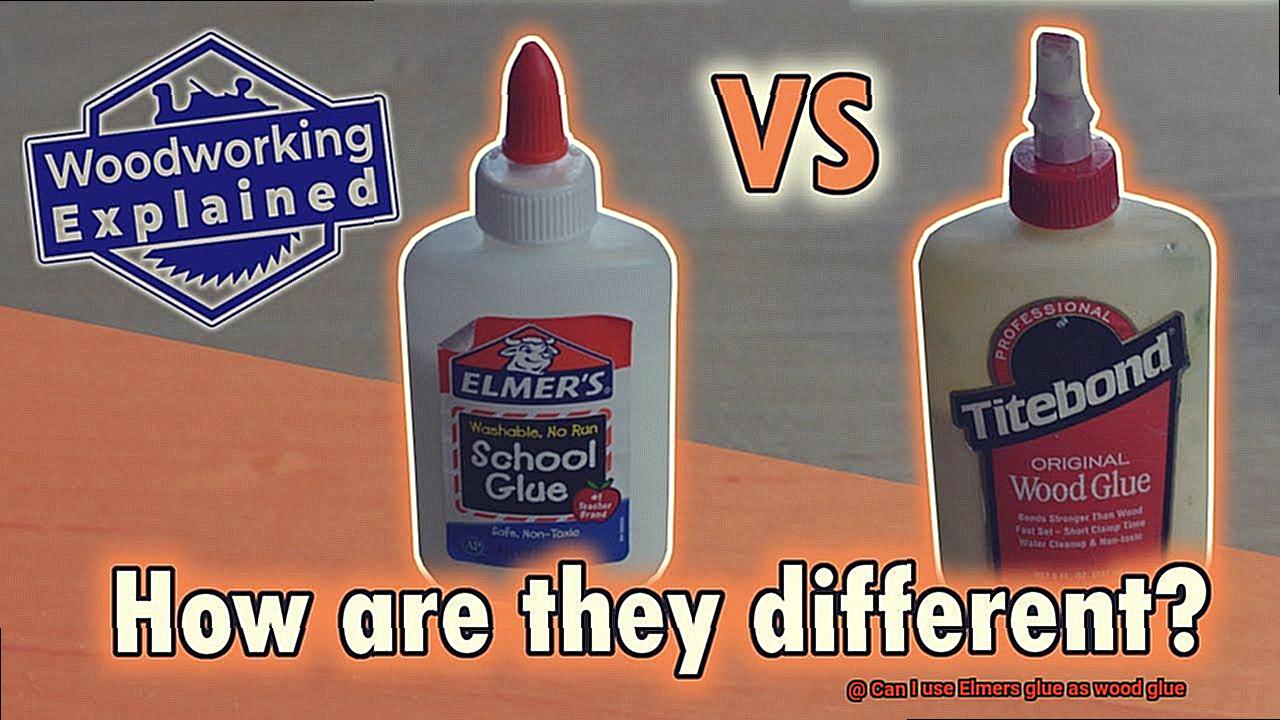
PVA glue is an all-around adhesive used in woodworking projects that require a strong bond but not heavy-duty work. Hide glue is a traditional adhesive that’s been used for centuries and is still popular among woodworkers. Epoxy glue is a two-part adhesive that creates a very strong bond and is ideal for filling gaps in wood or attaching metal to wood. Cyanoacrylate glue is fast-drying and excellent for small repairs or attaching small pieces of wood.
Tips for Working with Wood Glue
Working with wood glue can be a bit tricky, but with the right tips and tricks, you can achieve a strong and durable bond between your wooden pieces. Here are some essential tips to consider:
Choose the Right Glue:
Not all glues are created equal, especially when it comes to woodworking. It’s crucial to choose a specific wood glue that is designed to handle the stresses and movements typically associated with wood projects. Using any other type of glue, such as school glue, may weaken the bond and affect the project’s overall quality.
Clean the Surface:
Before applying the glue, ensure that the surface is clean and free of any dust or debris. The presence of dirt or dust can compromise the adhesive quality of the glue, leading to an unstable joint. Use a damp cloth to wipe the surface clean and let it dry before applying the glue.
Apply Evenly:
To achieve a strong bond, it’s important to apply the wood glue evenly across both surfaces you want to join. Applying too little glue can result in a weak bond, while using too much glue can cause it to seep out of the joint. Be generous but not excessive with your application.
Clamp Tightly:
Once you’ve applied the glue, clamp the joint tightly together. Clamping ensures that the pieces remain secure while drying. You can use various types of clamps depending on your project’s size and shape. Make sure there are no gaps or unevenness in the joint.
Clean Up Excess Glue:
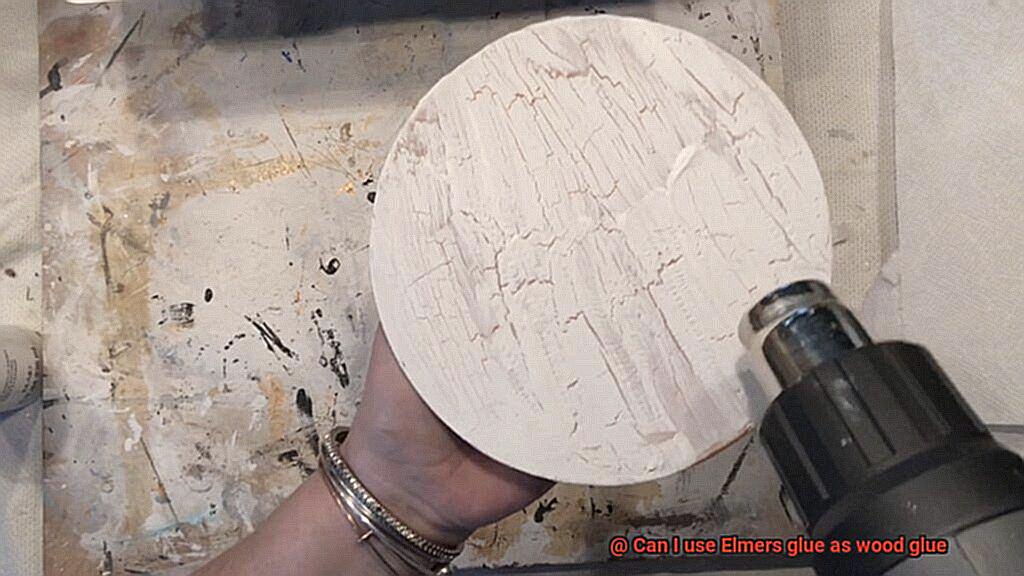
Accidents happen, and sometimes you may apply more glue than necessary or accidentally get glue on areas where it doesn’t belong. Use a damp cloth to wipe away any excess glue before it dries. Doing so will prevent any unsightly glue marks on your finished project.
Allow Ample Drying Time:
Finally, give your project enough time for the glue to dry completely before removing the clamps or handling it. The drying time may vary depending on the type of glue used, so always check the manufacturer’s instructions. Rushing the process can weaken the bond and compromise the project’s stability.
Common Mistakes When Using Elmer’s Glue as a Substitute for Wood Glue
While it can work in some situations, there are several common mistakes that people make when using Elmer’s glue that can lead to weak joints and project failures.
Firstly, one of the biggest mistakes is not using enough glue. Elmer’s glue is thinner than wood glue, so it’s essential to apply a sufficient amount to ensure a strong bond. If you use too little, the joint may not hold up over time. In addition, proper clamping is crucial because Elmer’s glue requires more clamping pressure than wood glue to achieve a strong bond. Use enough pressure to ensure that the joint is secure.
Another mistake many people make is using Elmer’s glue on large or heavy projects. This type of glue isn’t as strong as wood glue, and it may not be able to handle the weight of larger or heavier projects. Always opt for wood glue for these situations.
Not allowing enough drying time is another common mistake. Elmer’s glue takes longer to dry than wood glue, so be patient and allow enough time for the glue to fully dry before using the project. Rushing this step can result in weak joints that won’t hold up over time.
Lastly, avoid using Elmer’s glue on outdoor projects. This type of glue isn’t waterproof and will break down when exposed to moisture. For outdoor projects, always use a waterproof wood glue that will stand up to the elements.
In summary, while Elmer’s glue can be used as a substitute for wood glue in certain situations, it’s crucial to be aware of these common mistakes and take steps to avoid them for a successful project outcome. To achieve a strong and durable bond between wooden pieces every time, follow these tips and tricks:
What to Do If You Accidentally Use Elmer’s Glue on a Woodworking Project
Accidentally using Elmer’s glue instead of wood glue in your woodworking project can feel like the end of the world. But fear not, there are simple steps you can take to fix the mistake.
Step 1: Act fast.
If the glue is still wet, grab a damp cloth or paper towel and wipe it off quickly. This will prevent the glue from drying and making the situation worse.
Step 2: Remove excess glue.
If the glue has already dried, use a scraper or sandpaper to remove as much of the Elmer’s glue as possible. Be cautious not to damage the wood surface while doing so.
Step 3: Dissolve the glue.
Apply a solvent, like acetone or rubbing alcohol, to the affected area. This will help dissolve the glue and make it easier to remove. Use a clean cloth or paper towel to wipe away the dissolved glue.
Step 4: Apply wood glue.
After removing as much of the Elmer’s glue as possible, apply a thin layer of wood glue onto the affected area and clamp it down for at least an hour until it dries completely. This will ensure that the wood is properly bonded and your project is back on track.
Step 5: Sand it down.
If necessary, sand the area where the Elmer’s glue was applied. This will help to remove any remaining glue residue and prepare the surface for proper adhesive application. It is important to note that the sanded area may need to be re-stained or painted to match the rest of the project.
Alternatives to Using Elmer’s Glue for Woodworking Projects
When it comes to woodworking projects, choosing the right type of glue is critical to ensuring the success and longevity of the finished product. While Elmer’s glue may be a popular choice for school projects and crafts, it may not be the best option for woodworking. Luckily, there are several alternatives to Elmer’s glue that are specifically designed for woodworking projects.
Polyurethane glue is a waterproof adhesive that creates a strong bond between wood surfaces. This versatile adhesive can also be used on other materials such as metal and plastic. Its strength makes it ideal for projects that will be exposed to moisture or high humidity.
Epoxy glue is a two-part adhesive that creates an incredibly strong bond and is perfect for outdoor furniture or boats that will be exposed to water. In addition, epoxy glue is resistant to heat and chemicals, making it a versatile option for a variety of woodworking projects.
For those who prefer a more traditional approach, hide glue is a natural adhesive made from animal collagen. This adhesive has been used for centuries in woodworking and creates a strong bond that can be easily reversed if necessary.
It is important to consider the specific needs and requirements of your project before choosing a type of glue. By exploring alternative options such as polyurethane or epoxy glue, woodworkers can ensure that their finished products are durable and long-lasting.
L-VAyGxhs8s” >
Also Read: Can you use Elmer’s glue as a sealant?
Conclusion
In summary, while Elmer’s glue may seem like a quick fix for woodworking projects, it falls short when it comes to durability and strength. Wood glue is specifically designed to create a sturdy bond between wood pieces and can withstand wear and tear. Its exceptional strength, versatility across different types of woods, water-resistant and heat-resistant properties, easy clean-up with water, affordability, and availability make it the go-to adhesive for woodworking.
When choosing the right glue for your project, consider factors such as the material you are working with, how strong the bond needs to be, drying time, environmental factors like moisture or temperature changes, and which type of glue best suits your needs. Using Elmer’s glue as a substitute for wood glue can result in common mistakes such as inadequate amounts of glue or clamping pressure, using it on large or heavy projects, not allowing ample drying time or using it on outdoor projects.
If you mistakenly use Elmer’s glue on your woodworking project, act quickly by wiping off any wet glue or removing as much dried glue as possible before dissolving it with a solvent. Apply wood glue onto the affected area and clamp until dry before sanding if needed.
Alternatives to Elmer’s glue for woodworking projects include polyurethane glue for waterproofing needs; epoxy glue for its strength and resistance to heat and chemicals; and hide glue for those who prefer a more traditional approach.



